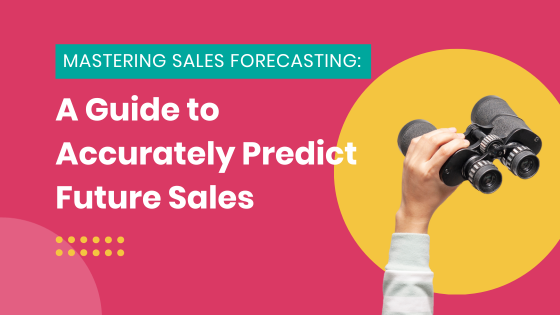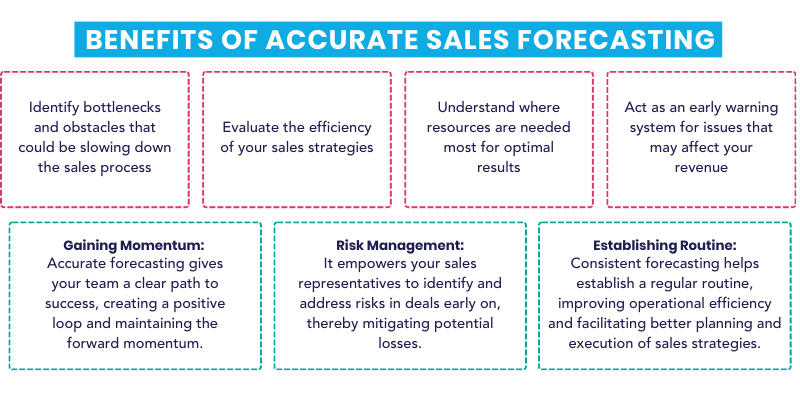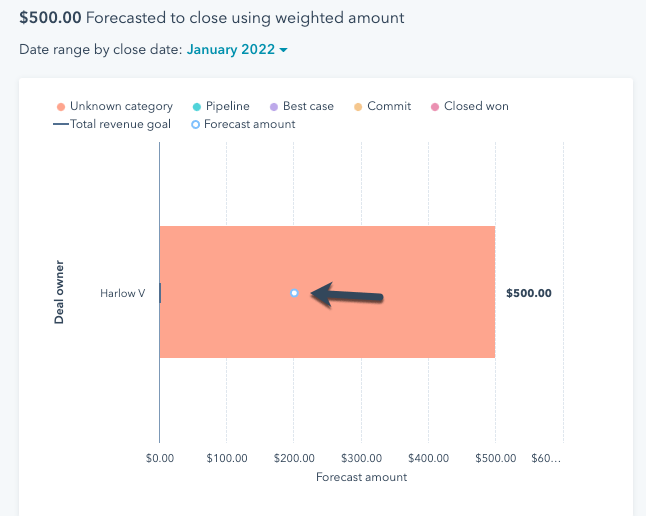


Mastering Sales Forecasting: Guide to Accurately Predict Future Sales




While the future of revenue may not be as predictable as the daily rise and fall of the sun, the art and science of sales forecasting can bring you strikingly close. Sales forecasting, when done accurately, can provide an almost clairvoyant insight into future sales revenue.
Being able to accurately predict future sales gives you the power to allocate resources efficiently, identify potential problems, and take advantage of emerging opportunities.
However, achieving accurate sales forecasting can be challenging, especially with constantly changing market dynamics and increasing competition. It's not as easy as having your reps give you a number. Sales forecasting requires insight into your pipeline, leading indicators, and a lot of cooperation.
The Importance of Sales Forecasting
The benefits of sales forecasting are multifaceted, but one of the most significant advantages lies in the visibility it provides into your pipeline health.

A transparent pipeline offers a clear view of how deals are progressing, which stages are bottlenecked, and which areas require immediate attention. This visibility is invaluable as it allows strategic decision-making, empowers your team to make necessary interventions, and ultimately, leads to more reliable forecasting and improved sales performance.
Gaining visibility into your pipeline health holds immense value for your organisation. It helps:
- Identify bottlenecks and obstacles that could be slowing down the sales process
- Evaluate the efficiency of your sales strategies
- Understand where resources are needed most for optimal results
- Act as an early warning system for issues that may affect your revenue
Beyond the visibility, sales forecasting offers additional benefits:
- Gaining Momentum: Accurate forecasting gives your team a clear path to success, creating a positive loop and maintaining the forward momentum.
- Risk Management: It empowers your sales representatives to identify and address risks in deals early on, thereby mitigating potential losses.
- Establishing Routine: Consistent forecasting helps establish a regular routine, improving operational efficiency and facilitating better planning and execution of sales strategies.
Accurate Sales Forecasting's Influence on Revenue Growth
On the surface, it might seem that regularly submitting weekly forecasts wouldn't directly lead to revenue growth. After all, they are merely predictions of future sales and not actual sales. However, it's the domino effect of this practice that truly holds the key to driving revenue growth.
Achieving a robust line of sight through sales forecasting can impact revenue growth in several ways:
- Identify At-Risk Deals: By gaining visibility into your sales pipeline, you can identify which deals are at risk of not closing. This early detection allows for proactive measures to be taken, potentially saving the deal and securing the anticipated revenue.
- Spot Ineffective Sales Tactics: A clear line of sight allows you to identify sales tactics that aren't yielding the expected results. By recognising these early, you can pivot the sales strategy to a more fruitful approach, thereby avoiding unnecessary revenue loss.
- Prioritise Deals: With complete visibility, you can identify which deals hold the greatest potential for revenue and should be prioritised. This ensures that your sales team focuses their efforts where they will have the most significant impact on revenue.
- Spot Inefficiencies in the Process: A clear line of sight into your sales process allows you to identify parts of the process that may not be as efficient as they could be, enabling process refinement and improved revenue generation.
- Review Closed-Lost Deals: Understanding the factors that led to a deal closing as lost allows you to learn from past mistakes. This insight can be used to streamline your sales process and tactics, ultimately improving your closing rate and boosting revenue.
Step-by-Step Guide to Creating a Sales Forecast
Building an effective sales forecast requires a systematic approach and careful consideration of various factors.
Step One: Choose Your Sales Forecasting Approach
There are a number of different ways to forecast sales:
Here are the different approaches to sales forecasting:
1. Qualitative ForecastingThis method relies on expert opinion, market research, and intuition rather than historical data. It's typically used when historical data is not available, such as for new product launches or entering new markets.
- Benefits: Allows for flexibility and the incorporation of varied industry insights.
- Drawbacks: High dependence on expert judgement can lead to biases and inaccuracies.
This approach is based on historical sales data and assumes that future forecasts will follow a similar pattern. Techniques used can include moving averages, exponential smoothing, or trend analysis.
- Benefits: Data-driven and objective, making it reliable when historical patterns are stable.
- Drawbacks: Less effective in volatile markets or with new products where historical data is lacking or not applicable.
3. Causal Model
This model assumes that the factor being forecasted is dependent on one or more other factors. For instance, sales could be dependent on market trends, economic indicators, or advertising spend.
- Benefits: Can provide accurate forecasts when the relationship between variables is well understood and stable.
- Drawbacks: Requires extensive data and a deep understanding of causal relationships, which may not always be available.
This approach begins with a larger market or industry perspective and then breaks it down into specific predictions for the company. It starts with macro-market research and industry trends.
- Benefits: Provides a broad perspective, incorporating overall market trends and conditions.
- Drawbacks: May overlook specifics of the business, leading to inaccuracies if the company’s performance does not align with the industry trend.
5. Bottom-up Sales Forecasting
This model starts at the individual sales rep level, predicting each rep’s performance based on their pipeline and then rolling up to a total company forecast.
- Benefits: Tends to be more accurate as it is based on actual deals in the pipeline, and considers the specifics of the business.
- Drawbacks: Can be time-consuming and depends on the accuracy of the input from sales reps. Bias and over-optimism of the reps can lead to overestimation.
Step Two: Establish your Data Foundations
Accurate sales forecasting hinges upon the quality of data within your Customer Relationship Management (CRM) system. While essential data like names, company names, and email addresses are certainly important, what we're referring to here are the leading indicators procured from our entire customer journey. These include:
- Engagement Score: This provides insight into how actively engaged a potential client is with your brand. Tracking interactions such as website visits, social media activity, and response to marketing materials can help gauge this.
- Relationship Score: This metric assesses the strength of the relationship between your business and the potential client. This relationship score is influenced by the ideal customer profile and number of relationships held across the company profile.
- Qualification Score: This score is built by collecting qualification metrics. The more these qualification criteria are influenced, the stronger the score. For example, referencing the MEDDPICC® methodology, if you are able to capture the Metrics, involve the economic buyer, understand the decision criteria, etc, the better the qualification score.
- Time in Stage: This metric tracks the length of time a prospect spends in each stage of the sales funnel. Long periods extending beyond average lengths in a single stage may indicate potential issues that need addressing.
By monitoring these leading indicators, you enrich your CRM data, enabling a more detailed and accurate sales forecast.
Step Three: Assign a status to every deal
To begin, it is important for every sales representative to allocate a status to each of their active deals. These statuses should accurately indicate the likelihood of a specific deal closing within the projected timeframe, which in our case is on a weekly basis.

At Six & Flow, we use the following categories in line with HubSpot's Forecasting tool:
- Pipeline: These are deals that are still in negotiation. They are not guaranteed to close and are still being worked on.
- Best Case: These deals have a high likelihood of closing, but they are not yet a certainty. They are the deals that sit in the middle ground between being a pipeline deal and a commit.
- Commit: These deals are almost guaranteed to close, with almost all the necessary conditions for a successful deal having been met.
HubSpot’s Weighted Pipeline Forecast Report & Forecast Tool
HubSpot's weighted pipeline forecast report and forecast tool are instrumental in creating a more realistic sales forecast.
Weighted Pipeline Forecast Report: This report uses the principle of assigning weighted probabilities to deals depending on which stage they're at in the sales process. The idea is that the closer the deal is to closing, the higher the probability it will close, and therefore, the higher the weight it carries in the forecast. This report provides a more nuanced view of your pipeline, accounting for the inherent uncertainty in deal outcomes.
Forecast Tool: HubSpot's Forecast tool is designed to help sales teams predict their sales revenue. It uses the deal categories (Pipeline, Best Case, Commit) to calculate the projected revenue for a given period. Using this tool, sales representatives can easily update deal amounts and close dates, thereby allowing for a dynamic and more accurate sales forecast.
Step Five: Creating a Comprehensive Rollup Forecast
Creating a comprehensive rollup forecast is an essential part of any successful sales forecasting process. A rollup forecast is a summary of all the individual forecasts that make up the total forecast. Then, sales managers can take this forecast and share it with leadership.
It is important to ensure that the rollup forecast is accurate and up-to-date in order to make the most informed decisions about future sales.
The rollup forecast should be reviewed and updated regularly. This will ensure that the forecast is up-to-date and reflects the most recent changes in the market. Additionally, it is important to review the forecast with stakeholders to ensure that everyone is on the same page and that the forecast is accurate. By regularly reviewing and updating the rollup forecast, you can ensure that your sales forecasting process is as accurate and reliable as possible.
Common Mistakes to Avoid in Sales Forecasting
When it comes to sales forecasting, there are common pitfalls that businesses should be aware of and avoid. By learning from these mistakes, you can enhance the accuracy and effectiveness of your sales forecasts.
Let's explore some of the common mistakes that businesses make in sales forecasting and how to avoid them:
Bloated Pipeline
A bloated pipeline refers to a sales pipeline that has an excessive amount of deals at any one time. While at first glance this might seem like a positive — a wealth of potential sales — it can in fact have negative implications for forecasting accuracy. With a bloated pipeline, it becomes inherently difficult to properly track and manage each deal, leading to a loss of focus and potentially neglecting high-value opportunities.
Moreover, not every deal in a bloated pipeline will come to fruition. Overestimating the probability of these deals closing can result in an overly optimistic forecast, creating an unrealistic expectation of the revenue to be generated. This can subsequently lead to disappointment and inadequate resource planning when the forecasted sales do not materialise.
Lastly, maintaining a bloated pipeline can be time-consuming and resource-intensive. Sales teams may spend a disproportionate amount of time on low-probability deals, causing high-probability opportunities to slip through the cracks. It is therefore essential to regularly review and qualify the deals in the pipeline, ensuring that the sales forecast is based on a realistic assessment of the opportunities available.
Forecasting with Emotions, Instead of Data
Another common pitfall in sales forecasting is letting emotions, rather than data, drive predictions. It's natural for sales reps to become invested in their deals, especially those that have required considerable time and effort. This emotional investment can lead to optimism bias, where reps overestimate the likelihood of deal closure simply because they want it to close. However, just wanting a deal to close does not guarantee that it will. This can lead to costly errors when it comes to forecasting.
Coming unprepared to forecast meetings and not making use of the available data can result in inaccurate predictions. It's crucial to approach these forecasts with a clear and objective view, making use of the metrics identified above to inform decisions. By grounding forecasts in solid data, reps can make more accurate predictions that truly reflect the reality of the sales landscape. This can improve the overall accuracy of the sales forecast and help avoid costly overestimations or underestimations of potential revenue.
Leveraging HubSpot AI Forecasting For Accurate Forecasting
HubSpot's artificial intelligence (AI) forecasting functionality offers a cutting-edge approach to sales forecasting. This functionality, known as Predictive Forecasting, utilises machine learning algorithms to analyse historical sales data and generate highly accurate sales forecasts. It takes into account multiple factors and trends in your sales data to provide a more realistic and reliable forecast.
Unlike traditional forecasting methods, Predictive Forecasting can process vast amounts of data and uncover complex patterns that might not be evident to human analysts. It can also adapt to changes in data over time, allowing for continuous improvements in forecast accuracy.
Furthermore, HubSpot's AI Forecasting integrates seamlessly with your existing HubSpot CRM. This means it considers all relevant deal information in your CRM, including deal stage, deal amount, close date, and more, when calculating forecasts. As a result, it offers a comprehensive, data-driven view of future sales performance and helps businesses make informed decisions.
Achieving Business Growth through Accurate Sales Forecasting
Sales forecasting is essential for any business looking to grow and succeed. Accurate forecasting allows businesses to plan for the future, anticipate customer needs, and make informed decisions about their operations. By understanding the trends in their industry, businesses can make better decisions about their sales strategies and ensure they are well-positioned to capitalise on opportunities.
In conclusion, sales forecasting is an essential tool for businesses to accurately predict future sales and drive business growth. By understanding the importance of sales forecasting, the key factors that influence it, and the steps to creating an effective sales forecast, businesses can ensure they are making the most of their sales opportunities. Additionally, by avoiding common mistakes, leveraging HubSpot AI forecasting, and continuously evaluating sales opportunities, businesses can enhance their sales forecast accuracy and achieve business growth. With the right approach and tools, businesses can master sales forecasting and unlock their potential for success.








